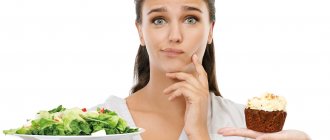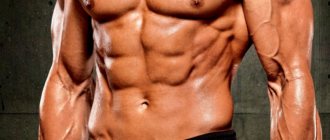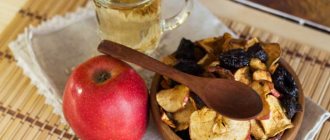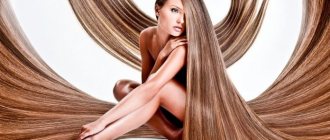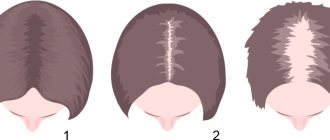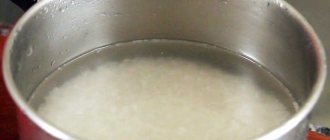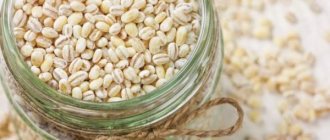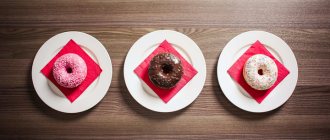What is important to know about hair
Hair is the fastest growing tissue in the body. Their length increases monthly by about 1 cm. Hair grows fastest at the age of 15-30 years; for 40-year-olds, this figure decreases noticeably. Meanwhile, this process depends on many factors, including genetics, gender, and hormonal levels. Deficiency of zinc, proteins and iron also affects the indicator. But to understand the principles of hair growth, it is important to understand what hair actually is. Hair is made up of the protein keratin (which is also the main component of nails). They are formed from 3 layers:
- external (cuticle) – thin, colorless, plays the role of a protective coating;
- medium – contains melanin, responsible for the color and shape of hair;
- internal - responsible for the reflection of light.
The living part of the hair is located under the skin, where there is a follicle with a root. And it is the follicle that draws all the necessary nutrients from the blood. It is believed that there are from 100 thousand to 350 thousand follicles on the head of an adult. By the way, researchers say that blondes have the most hair, and red-haired people have the least. Hair grows from each follicle for 1000 days (3 years), then rests for 100 days (3 months). After this, new hair grows from the follicle again. This is a model of so-called healthy growth, however, there are many factors that can destroy this pattern. And poor nutrition is one of them.
Other reasons include:
- age (over the years, hair loses strength, falls out, turns grey);
- genetics (the tendency to early baldness or graying can be transmitted from parents);
- repeated weight loss and restoration (curls become fragile and lack shine);
- Hormonal imbalance (causes significant hair loss).
Nutrition and hair
Hair restoration is the ultimate goal in the treatment of any patient. However, the degree of hair restoration depends on the initial diagnosis, the factors underlying the disease, the presence of concomitant diseases, and the effectiveness of the treatment itself.
Depending on the type of hair loss, various hair restoration products are used. It must be remembered that the approach used is comprehensive and individually selected for each patient. However, even with this, it is not always possible to achieve complete hair restoration after baldness.
The success of hair treatment for men and women depends on many factors. One of the significant factors is the moment of treatment. The earlier the patient begins complex therapy, the greater the chance of hair restoration he has. This is true for any type of baldness in women and men.
The complex treatment for restoring lost hair includes a balanced diet, recommendations for optimizing work and rest, proper hair care, searching for the causes that led to hair loss, their correction, prescribing means and methods for treating hair loss.
Therefore, in the case of each patient, an individual program for treatment and hair restoration is selected.
For example, with androgenetic hair loss in men, hair restoration is possible with regular use of products to stimulate hair growth, in combination with external and/or systemic antiandrogenic drugs. A combination with physiotherapeutic methods of treatment, mesotherapy, etc. is also possible. The degree of hair restoration depends on the time of initiation of therapy and the regularity of the courses of treatment.
As for hyperandrogenic alopecia in women, the success of hair restoration depends entirely on the correction of hormonal disorders underlying hair loss, as well as on the timeliness of treatment. The principles of treatment largely coincide with those in the treatment of androgenetic hair loss in men.
Stress factors, dietary habits, chronic diseases, and taking certain medications play an important role in the development of chronic diffuse hair loss. Therefore, the degree of hair restoration, even with well-chosen complex treatment, always varies. It is necessary to identify all factors that may underlie prolapse in each individual patient. Only this can lead to the long-awaited hair restoration, which often takes a long time.
Hair restoration for patchy hair loss in men and women is not an easy task. At the same time, it is also necessary to assess the degree of imbalance of the immune system, which underlies the development of the disease, as well as to correct concomitant diseases. Without this, complete hair restoration is very difficult to achieve in some forms of the disease.
Thus, hair restoration is a labor-intensive process, so treatment must be selected only from a trichologist. The degree of hair restoration is different for each patient; the success of treatment also largely depends on the patient himself.
Do the beauty and health of hair depend on what, how and when we eat? According to experts, this question is far from idle. The world-famous trichologist Philip KINGSLEY (London) and Candidate of Medical Sciences, leading trichologist at the Specialized Trichological Center Olga KANDALOVA (Moscow) talk about how to properly organize nutrition during hair loss.
Olga KANDALOVA: “Restoring hair health is a long process”
I, like any other trichologist, quite often hear from patients: “I take care of my hair, take vitamins, follow a diet, eat only healthy foods (fruits, salads, vegetables, juices), and my hair constantly breaks and falls out. . Why?". There may be several reasons why hair falls out, and to find out, you need to start with a detailed conversation.
First of all, I ask the patient about the nature of his diet, and I do this not by chance. In many cases, it turns out that hair problems arise because a person does not receive enough protein. The reason for this may be both insufficiently thought out nutrition and various restrictive diets.
The most striking example of a restrictive diet is vegetarianism. There are people who naturally have healthy and beautiful hair, and it is not affected by any nutritional factors or living conditions. Yet according to statistics, vegetarians have more hair problems than anyone else. The fact is that hair contains protein (protein), and therefore adequate protein intake is vital for healthy and strong hair. Proteins consist of amino acids, some of which are essential, that is, not found in non-protein foods, while other amino acids can be obtained by eating plant foods. Essential amino acids are arginine, lysine, leucine, zaline, phenylalanine, tryptophan, threonine, isoleucine, histidine. These amino acids are found in sufficient quantities in animal proteins and are well absorbed by the body, that is, they are bioavailable. Eating only plant foods leads to a deficiency of essential amino acids in the body, namely they are the building material for each new hair. Every meal should be carefully thought out, and this does not require any special effort. For example, for a complete breakfast, it is enough to add an egg (or two eggs), ham or bacon to fruit or porridge. And during lunch, sometimes it is enough to add 120-150 grams of chicken, fish or meat to an ordinary salad, which does not contain proteins. If the breaks between meals are more than four hours, then during this time you need to eat some fresh or dried fruits, raw vegetables, black bread, and oatmeal cookies. As for people on diets that limit animal proteins, they need to take in amino acids to produce the required amount of energy. This is especially true for adolescents and people with pathologies of internal organs. We advise such patients to use gelatin-based proteins, since gelatin has a beneficial effect on the function of the hair follicle.
The cause of various hair pathologies can also be a lack of vitamins and microelements in food. Many confidently claim that modern Europeans, like you and me, do not lack either vitamins or microelements and that to restore their possible deficiency it is enough to simply eat well. This opinion is deeply erroneous: vitamin deficiency can occur in any person, regardless of age and region of residence. It can be caused by an unbalanced diet, prolonged use of medications (antibiotics, hormones, etc.), certain somatic diseases (for example, those associated with digestive disorders), and alcohol abuse. Unlike hormones produced by the body, vitamins are essential organic substances that are not synthesized in sufficient quantities in humans and enter the body only with food. Vitamins B, A, E, and D are especially important for hair growth. To choose the right vitamin preparation, you should find a doctor who has time for a detailed conversation, based on which he can determine which vitamins a particular patient is lacking.
For the full functioning of hair follicles, microelements (chemical elements present in the human body in concentrations less than 0.01%) are also necessary. These are iron, fluorine, silicon, zinc, copper. The body contains even less manganese, selenium, chromium, lithium, and cobalt. Some trace elements, even if they are not essential, can, however, provoke various pathologies. The most important for hair growth and development are iron, zinc, selenium, silicon, and sulfur. These are basic elements, the need for which is rarely met by nutrition, so they must be prescribed additionally in the form of various drugs for many hair diseases.
The food must also contain a sufficient amount of carbohydrates - a source of glucose, which in turn provides energy for all cells, including the cells of the hair follicles. At the same time, cakes, ice cream, and chocolate containing carbohydrates are not considered healthy food. They overload the gastrointestinal tract, and therefore it is advisable to limit such foods. In addition, excess carbohydrates aggravate the condition of seborrhea of the scalp.
Every person who seeks to restore hair health must remember that it will take some time to obtain the effect of using any additional nutritional components and changing the diet. If a patient with a hair disease eats right, takes vitamins and microelements, it will take at least two months to get a therapeutic effect. But since hair grows only 12-15 mm per month, it will take at least six months to consolidate the effect. This needs to be explained to patients, since many of them, not seeing quick results, stop taking all recommended medications.
Useful vitamins and minerals
Hair, being part of the complex human body, also needs multivitamins and minerals. Without receiving enough of these beneficial substances, curls stop growing and become fragile.
As a rule, to solve this problem it is enough to restore the balance of nutrients in the body.
But for this it is important to understand what role this or that substance will play for the hair and where to get it. Important vitamins
| Vitamin name | What is hair needed for? | Where to get |
| B1 (thiamine), B2 (riboflavin), B3 (niacin) | Nourishes the follicle | Beef, cheese, eggs, cereals, yeast |
| B5 (pantothenic acid) | Gives flexibility, strength, shine, prevents hair loss and graying | Peas, liver, caviar, oatmeal, cauliflower |
| B6 (pyridoxine) | Prevents dandruff | Cereals, liver, egg yolk |
| B7 (biotin) | Prevents hair loss, maintains hair strength and texture | Eggs, liver, soy, cheese, chicken, yeast |
| B9 (folic acid) | Prevents gray hair, improves growth | Nuts, grains, beans, liver, fish |
| AT 12 | Prevents baldness | Fish, eggs, chicken, milk |
| C (ascorbic acid) | Necessary for the production of collagen, an antioxidant that protects follicle cells, essential for dry hair, strengthens capillaries that supply hair with nutrients | Citrus fruits, kiwi, rose hips, broccoli, gooseberries, strawberries, blueberries |
| E (tocopherol) | Preserves the integrity of the follicle membranes, maintains the health of curls, protects against UV radiation | Seeds, nuts |
| A (beta-carotene) | Essential for healthy growth, improves the synthesis of collagen and subcutaneous fat, which acts as a natural conditioner | Sweet potatoes, carrots, peppers, orange and yellow vegetables |
| D (calciferol) | Activates hair growth | It is enough to spend 10-15 minutes in the sun every day |
Important Minerals
| Item name | What is hair needed for? | Where to get |
| Selenium | Deficiency leads to poor growth | Eggs, beef, oysters, rye bread |
| Silicon | The strength and durability of curls depends on it | Root vegetables, zucchini, cucumbers |
| Calcium | Important for rapid hair growth | Dairy products, dark green vegetables, herbs |
| Zinc | Medicine against baldness and early graying | Beef, eggs, seafood, whole grains, onions, garlic, cabbage |
| Iron | Its deficiency causes anemia and hair loss, early gray hair | Dark green vegetables, red meat, fatty fish, pomegranates, liver, eggs, buckwheat |
| Iodine | Important for the healthy functioning of the thyroid gland, which determines the rate of hair growth | Seafood, seaweed, champignons, persimmon |
| Omega-3 fatty acids | Moisturizes hair and scalp | Salmon, herring, trout, mackerel, avocado, pumpkin seeds, walnuts |
| Magnesium | Gives elasticity | Dried apricots, greens, nuts |
| Phosphorus | Responsible for elasticity and color saturation | Fish, legumes |
| Sulfur | Important for shine | Legumes, garlic, fish |
| Copper | Retains color | Chocolate, buckwheat, oatmeal, pearl barley |
Benefit from…
...proteins
Proteins are the most important nutrients for maintaining healthy hair. A special type of protein, keratin, is responsible for their strength and flexibility. Severe protein deficiency causes baldness.
You can get the necessary proteins from red meat, fish, omelettes, chicken breast, and soy products. Also, do not forget about beans and other legumes and grains, such as rice, wheat, corn, which can provide the body with a wide range of amino acids.
| Amino acid name | What is it for? |
| L-methionine | One of the 4 sulfur-containing amino acids that maintain hair strength, provide sulfur necessary for the formation of healthy connective tissue, and is responsible for the beautiful appearance of curls |
| L-cysteine | Prevents hair loss |
| L-lysine | Deficiency leads to baldness |
| Tyrosine | Prevents early gray hair |
...carbohydrates
Depletion of the body's carbohydrate reserves often results in hair loss. This explains why many people on low-carb diets notice excessive hair loss, which tends to become dull and lifeless.
You can restore reserves of complex (healthy) carbohydrates from whole grains, brown rice, wholemeal products, and oatmeal.
...fats and fatty acids
A healthy diet includes healthy fats, which should include Omega-3 fatty acids. The best source of this substance is fish oil. Polyunsaturated fatty acids play an important role in maintaining healthy cell structure.
They act as a barrier and are necessary for the synthesis of lipids. Polyunsaturated acids are essential for dry, scaly hair. Other popular sources of these substances are walnuts, flaxseed oil, and fish oil. A deficiency of these substances usually results in baldness.
Menu (Power Mode)
The daily diet should contain a large amount of vegetables and fruits. It is also important to get omega-3 PUFAs into your body, so more often include flax seeds, herring, salmon, mackerel, trout, halibut, walnuts, fish oil, cod liver, olive oil in your diet - this will diversify your diet and benefit hair health and the body as a whole.
You should prefer lean meat. It is useful to prepare it by boiling or baking. A healthy diet involves significant limitation of simple carbohydrates and avoidance of foods containing chemical additives (sausage, ham, smoked meats, frozen and dry semi-finished products).
| Breakfast |
|
| Lunch |
|
| Dinner |
|
| Afternoon snack |
|
| Dinner |
|
| For the night |
|
| Breakfast |
|
| Lunch |
|
| Dinner |
|
| Afternoon snack |
|
| Dinner |
|
| For the night |
|
| Breakfast |
|
| Lunch |
|
| Dinner |
|
| Afternoon snack |
|
| Dinner |
|
| For the night |
|
How to stop hair aging
No matter how hard a person tries to prolong youth, but with age, processes are launched in the body that cannot be prevented. This also applies to hair. Over the years, they can change color, structure, density. Meanwhile, there is a good chance of delaying this moment. Researchers say that spirulina, chlorella, broccoli, blueberries, raspberries, strawberries, blackberries, garlic, ginger and other plants that have beneficial properties will help slow down the aging of hair.
But the most important component of anti-aging nutrition is water. It is extremely important to maintain water balance in the body and prevent dry skin and hair.
What do hair problems mean?
Dull and weakened skin is the result of protein deficiency.
They get fat quickly - they lack B-group vitamins.
Very dry and split ends - they lack essential fatty acids.
Brittle, devoid of vibrant shine - a sign of tyrosine and zinc deficiency.
Thin ones are a signal of iron deficiency in the body.
Excessive hair loss is characteristic of a deficiency of vitamins B and iron.
Early gray hair is a sure sign of a lack of iron, copper, B vitamins, and the amino acid tyrosine.
Dry scalp – this problem indicates a lack of vitamin A.
They grow slowly - foods rich in biotin will help get rid of this problem.
Top list of products important for healthy hair
Fish
Salmon, herring, trout, and mackerel provide the body with Omega-3 fatty acids, proteins, vitamin B12 and iron. A deficiency of essential fatty acids leads to dry scalp and dull hair. Vegetarians can eat walnuts as an alternative.
Dark green vegetables
Broccoli, spinach, and chard provide the body with vitamins A and C, which are necessary for the production of subcutaneous fat, which is extremely important for hair follicles. Also, dark green vegetables are the best sources of iron and calcium.
Legumes
Beans, lentils and other legumes provide the body with protein, iron, zinc and biotin. It would be useful to remind you that biotin is one of the main elements that hair needs. Its deficiency leads to brittle curls.
Nuts
There are probably no nuts that are not beneficial for hair. Brazilian, for example, supplies selenium, walnuts contain zinc, alpha-linolenic acid, Omega-3 fatty acids, which maintain healthy curls. Cashews and almonds are rich in zinc, the deficiency of which causes baldness.
Bird
Poultry is a source of high-quality protein and iron with high bioavailability. Weak and brittle hair is a sign that it is not getting enough proteins.
Eggs
This product is important for hair as an excellent source of biotin, protein and vitamin B12, which are important for beautiful curls.
Whole grain
Whole grain cereals for breakfast will provide your hair with enough iron, zinc and B vitamins.
Seafood
Seafood is typically rich in zinc, a healthy antioxidant mineral.
Low-fat dairy products
Calcium and casein, obtained from dairy products, are important elements for healthy hair growth.
Carrots, beets
These delicious, colorful vegetables are essential sources of vitamin A, potassium and magnesium for the body.
Almond oil
Contains many nutrients, including vitamin E, which keeps hair shiny and strong. Studies show that daily use of this product accelerates hair growth by 42%.
Cinnamon
This spice improves blood circulation, resulting in more nutrients and oxygen reaching the hair follicles.
Authorized Products
Hair strengthening nutrition includes:
- Daily consumption of 400-500 g of vegetables. It is advisable to consume them fresh. A mandatory component of the diet is various legumes, as they are a source of essential vegetable protein, zinc, B vitamins and fiber. In the absence of bloating, you need to include them in your diet daily.
- 200 g of fruits and berries, consumed raw, as well as freshly squeezed juices. Among the fruits to improve hair condition, you need to choose those with a high content of vitamin C : rose hips, kiwi, citrus fruits, black currants, cranberries, lingonberries. Fruit fiber normalizes intestinal function.
- Soups made from vegetable broths with the addition of vegetables and cereals.
- Fish and seafood dishes. Prefer fatty fish, alternating with low-fat fish, steamed or baked. Sea kale is a storehouse of vitamins and microelements, so it should be included in your diet daily.
- Boiled or baked lean meat and poultry - beef, lean lamb, turkey, chicken (skin must be removed).
- Rye, grain bread or with bran, low-fat and savory cookies, whole grain bread.
- Fermented milk products and low-fat cottage cheese, low-fat sour cream and cheeses. Daily consumption of boiled eggs is recommended.
- Buckwheat, oatmeal, millet, wheat cereals, brown rice. Prepare crumbly porridge in water. Porridge must be included in the diet at least once a day. Make it a rule to eat buckwheat or oatmeal for breakfast with the addition of fresh fruits, dried fruits, seeds or nuts.
- Unrefined vegetable oils - olive, sesame, hemp and flaxseed oils are useful.
- Sesame and flax seeds are additional sources of omega-3 and phytosterols , which have a positive effect on the condition of skin and hair. The seeds are added to many dishes (porridge, salads, muesli) - this will bring double the benefits. Sesame seeds have a dense shell that interferes with the absorption of the substances they contain, so the seeds must be chewed thoroughly, but it is better to grind them in a coffee grinder in small portions and add them to dishes. You need to eat 2 tbsp per day.
- Any nuts, as they are a source of monounsaturated fatty acids (MUFAs), which should make up 60% of total fat in the diet. Their main function is to activate metabolic processes
- Walnuts are a source of alpha-linoleic acid, and Brazil nuts are an additional source of selenium, which is necessary to strengthen the hair column. You need to eat 30-40 g of raw nuts and seeds daily. In addition to nuts, MUFAs contain oils: olive, walnuts, canola and grape seed.
- Green tea, fruit and vegetable juices, infusion of rose hips and herbs, still mineral water.
Table of permitted products
| Proteins, g | Fats, g | Carbohydrates, g | Calories, kcal | |
Vegetables and greens | ||||
| eggplant | 1,2 | 0,1 | 4,5 | 24 |
| beans | 6,0 | 0,1 | 8,5 | 57 |
| zucchini | 0,6 | 0,3 | 4,6 | 24 |
| cabbage | 1,8 | 0,1 | 4,7 | 27 |
| broccoli | 3,0 | 0,4 | 5,2 | 28 |
| carrot | 1,3 | 0,1 | 6,9 | 32 |
| chickpeas | 19,0 | 6,0 | 61,0 | 364 |
| cucumbers | 0,8 | 0,1 | 2,8 | 15 |
| salad pepper | 1,3 | 0,0 | 5,3 | 27 |
| parsley | 3,7 | 0,4 | 7,6 | 47 |
| iceberg lettuce | 0,9 | 0,1 | 1,8 | 14 |
| soybeans | 34,9 | 17,3 | 17,3 | 381 |
| tomatoes | 0,6 | 0,2 | 4,2 | 20 |
| pumpkin | 1,3 | 0,3 | 7,7 | 28 |
| dill | 2,5 | 0,5 | 6,3 | 38 |
| beans | 7,8 | 0,5 | 21,5 | 123 |
| lentils | 24,0 | 1,5 | 42,7 | 284 |
Fruits | ||||
| avocado | 2,0 | 20,0 | 7,4 | 208 |
| oranges | 0,9 | 0,2 | 8,1 | 36 |
| bananas | 1,5 | 0,2 | 21,8 | 95 |
| pomegranate | 0,9 | 0,0 | 13,9 | 52 |
| grapefruit | 0,7 | 0,2 | 6,5 | 29 |
| pears | 0,4 | 0,3 | 10,9 | 42 |
| kiwi | 1,0 | 0,6 | 10,3 | 48 |
| lemons | 0,9 | 0,1 | 3,0 | 16 |
| mango | 0,5 | 0,3 | 11,5 | 67 |
| tangerines | 0,8 | 0,2 | 7,5 | 33 |
| nectarine | 0,9 | 0,2 | 11,8 | 48 |
| peaches | 0,9 | 0,1 | 11,3 | 46 |
| apples | 0,4 | 0,4 | 9,8 | 47 |
Berries | ||||
| gooseberry | 0,7 | 0,2 | 12,0 | 43 |
| Red currants | 0,6 | 0,2 | 7,7 | 43 |
| black currant | 1,0 | 0,4 | 7,3 | 44 |
Mushrooms | ||||
| mushrooms | 3,5 | 2,0 | 2,5 | 30 |
Nuts and dried fruits | ||||
| nuts | 15,0 | 40,0 | 20,0 | 500 |
| raisin | 2,9 | 0,6 | 66,0 | 264 |
| dried figs | 3,1 | 0,8 | 57,9 | 257 |
| cashew | 25,7 | 54,1 | 13,2 | 643 |
| dried apricots | 5,2 | 0,3 | 51,0 | 215 |
| almond | 18,6 | 57,7 | 16,2 | 645 |
| flax seeds | 18,3 | 42,2 | 28,9 | 534 |
| sunflower seeds | 20,7 | 52,9 | 3,4 | 578 |
| dried apricots | 5,0 | 0,4 | 50,6 | 213 |
| prunes | 2,3 | 0,7 | 57,5 | 231 |
Cereals and porridges | ||||
| buckwheat (kernel) | 12,6 | 3,3 | 62,1 | 313 |
| oat groats | 12,3 | 6,1 | 59,5 | 342 |
| pearl barley | 9,3 | 1,1 | 73,7 | 320 |
| brown rice | 7,4 | 1,8 | 72,9 | 337 |
Flour and pasta | ||||
| buckwheat noodles | 14,7 | 0,9 | 70,5 | 348 |
Bakery products | ||||
| bran bread | 7,5 | 1,3 | 45,2 | 227 |
| whole grain bread | 10,1 | 2,3 | 57,1 | 295 |
Confectionery | ||||
| Maria cookies | 8,7 | 8,8 | 70,9 | 400 |
Dairy | ||||
| skim milk | 2,0 | 0,1 | 4,8 | 31 |
| kefir 1.5% | 3,3 | 1,5 | 3,6 | 41 |
| Ryazhenka | 2,8 | 4,0 | 4,2 | 67 |
| natural yogurt 2% | 4,3 | 2,0 | 6,2 | 60 |
Cheeses and cottage cheese | ||||
| cottage cheese 1% | 16,3 | 1,0 | 1,3 | 79 |
| curd tofu | 8,1 | 4,2 | 0,6 | 73 |
Meat products | ||||
| beef | 18,9 | 19,4 | 0,0 | 187 |
| rabbit | 21,0 | 8,0 | 0,0 | 156 |
Bird | ||||
| boiled chicken breast | 29,8 | 1,8 | 0,5 | 137 |
| boiled turkey fillet | 25,0 | 1,0 | — | 130 |
Eggs | ||||
| soft-boiled chicken eggs | 12,8 | 11,6 | 0,8 | 159 |
Fish and seafood | ||||
| squid | 21,2 | 2,8 | 2,0 | 122 |
| flounder | 16,5 | 1,8 | 0,0 | 83 |
| salmon | 19,8 | 6,3 | 0,0 | 142 |
| mussels | 9,1 | 1,5 | 0,0 | 50 |
| pollock | 15,9 | 0,9 | 0,0 | 72 |
| seaweed | 0,8 | 5,1 | 0,0 | 49 |
| salmon | 21,6 | 6,0 | — | 140 |
| cod | 17,7 | 0,7 | — | 78 |
| trout | 19,2 | 2,1 | — | 97 |
| hake | 16,6 | 2,2 | 0,0 | 86 |
Oils and fats | ||||
| linseed oil | 0,0 | 99,8 | 0,0 | 898 |
| olive oil | 0,0 | 99,8 | 0,0 | 898 |
| sunflower oil | 0,0 | 99,9 | 0,0 | 899 |
Non-alcoholic drinks | ||||
| mineral water | 0,0 | 0,0 | 0,0 | — |
| green tea | 0,0 | 0,0 | 0,0 | — |
Juices and compotes | ||||
| apricot juice | 0,9 | 0,1 | 9,0 | 38 |
| carrot juice | 1,1 | 0,1 | 6,4 | 28 |
| peach juice | 0,9 | 0,1 | 9,5 | 40 |
| plum juice | 0,8 | 0,0 | 9,6 | 39 |
| tomato juice | 1,1 | 0,2 | 3,8 | 21 |
| pumpkin juice | 0,0 | 0,0 | 9,0 | 38 |
| rose hip juice | 0,1 | 0,0 | 17,6 | 70 |
| * data is per 100 g of product | ||||

